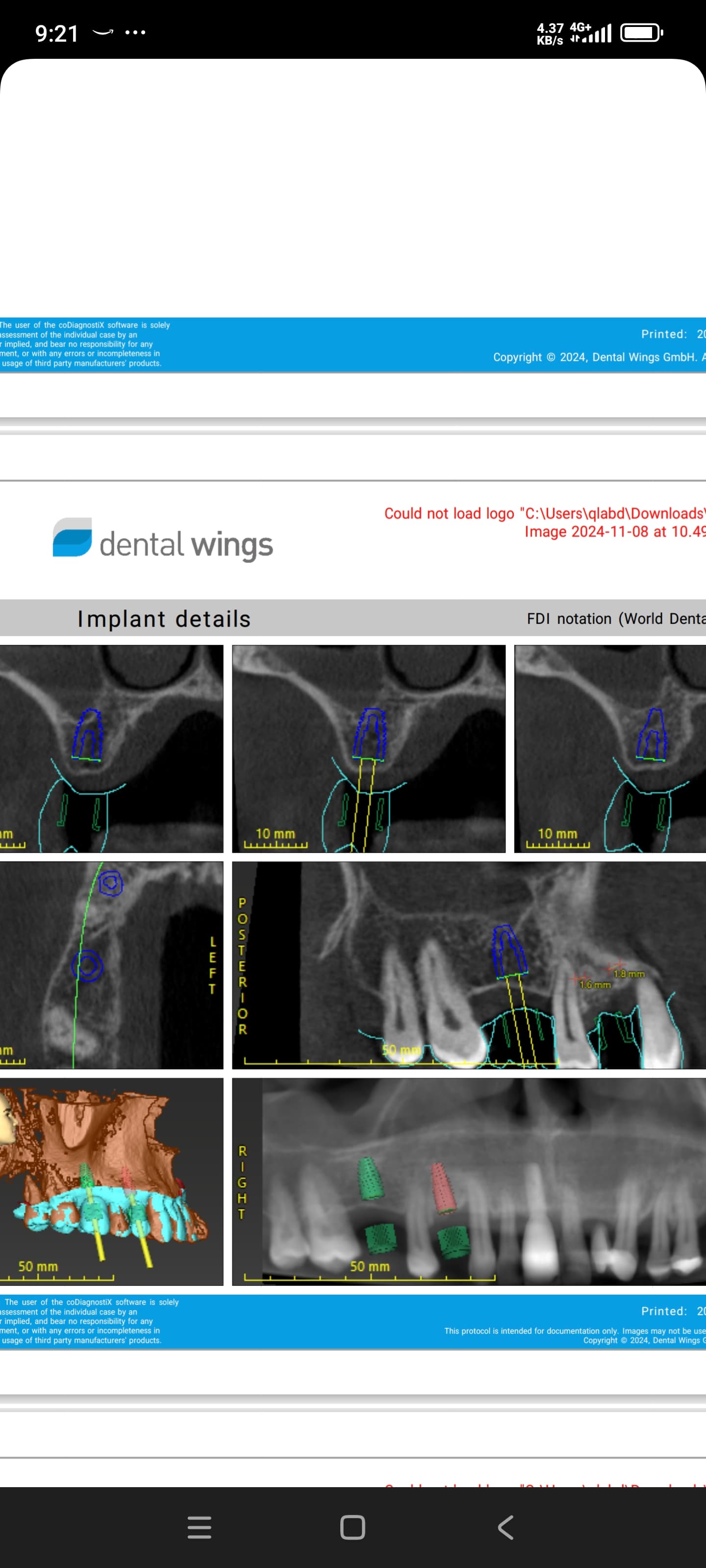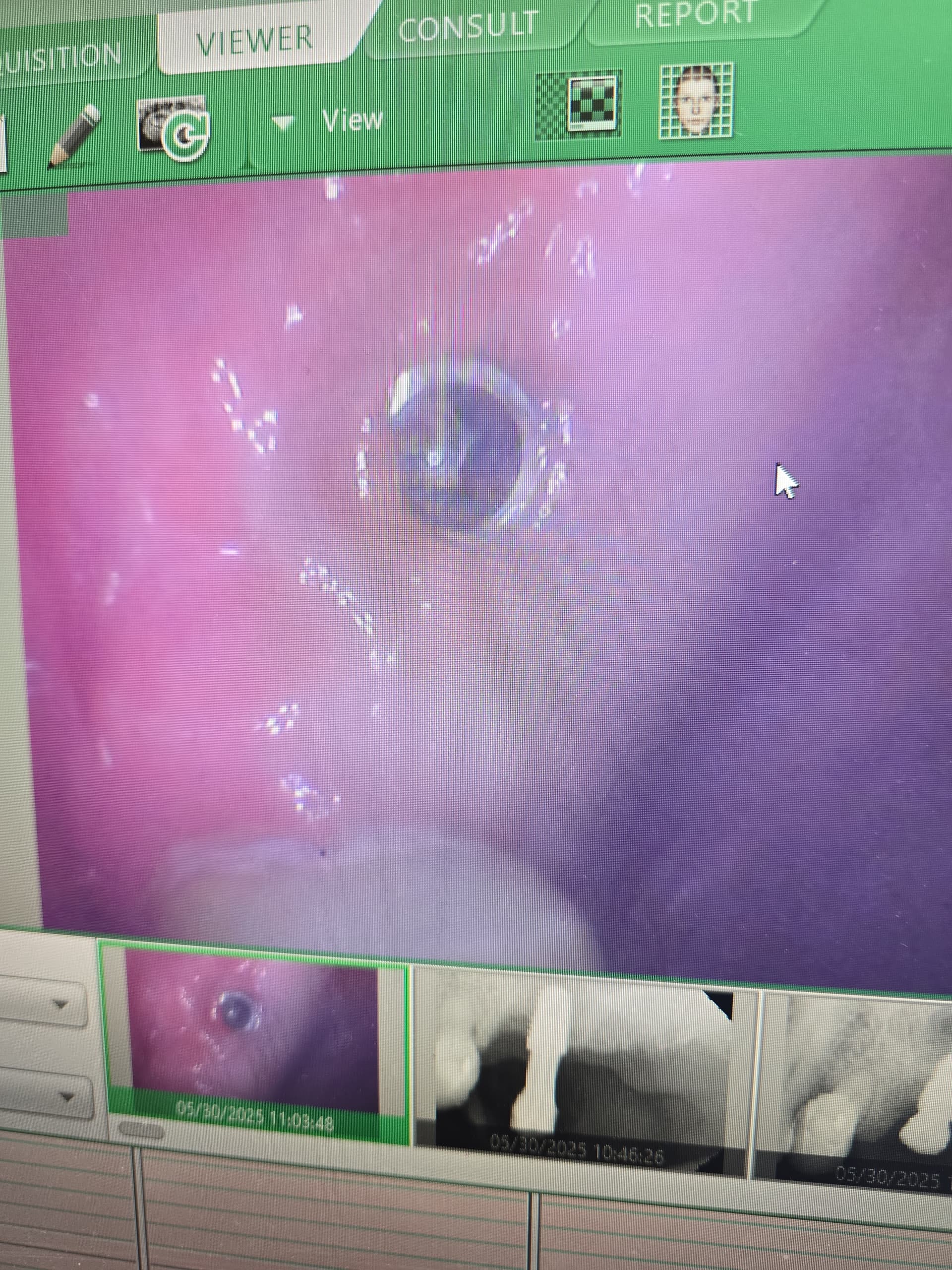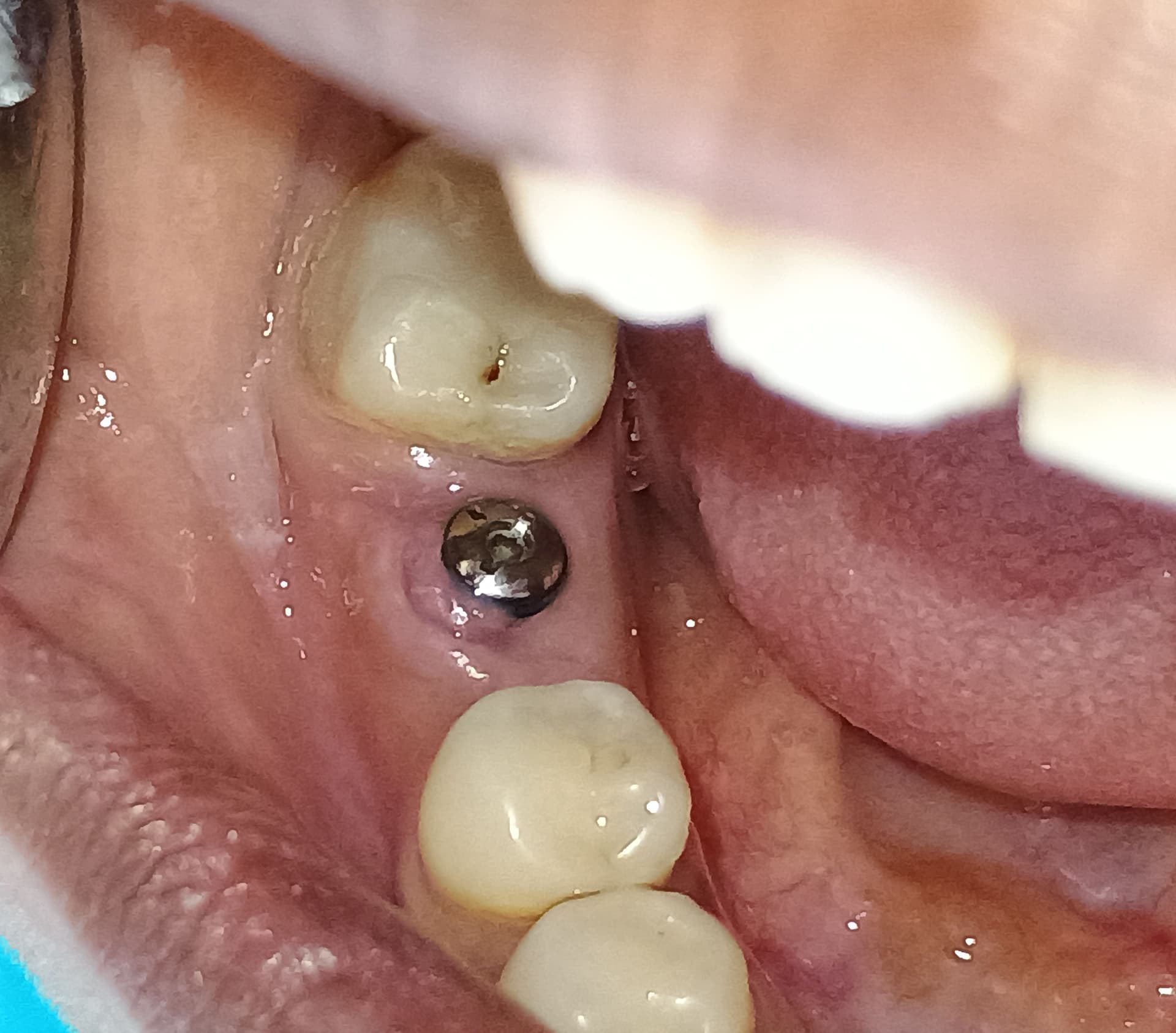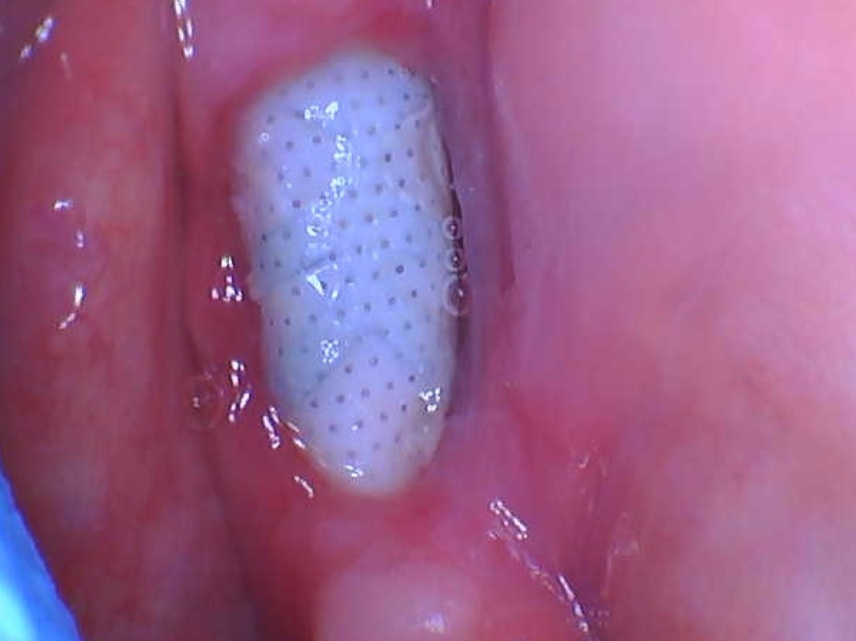Normal dieback or implant failure?
A 70-year old female with well controlled diabetes presented with a non-restorable #10 with bone loss. An atraumatic extraction was accomplished and socket preservation was completed by a different dentist in the office. 5 months later a Legacy3 3.2×11.5 implant was placed with good primary stability. After restoration it was noted that there was bone loss along the crest of the implant. The patient was very pleased with the restoration. Is this normal die-back or implant failure? Is there anything that should be done at this point?

38 Comments on Normal dieback or implant failure?
New comments are currently closed for this post.
Timothy C Carter
1/31/2018
Normal... You should expect bone loss to the level of the first thread. Especially with a Legacy which is possibly the worst connection in the industry.
Gerald Niznick
2/1/2018
Legacy has the same internal hex connection as Zimmer’s Screw—Vent with 30 years of documents success. BioHorizon, MIS, Adin and many other companies have copied it exactly. The NobelActive is a slight variation with a 78 instead of 45 lead-in bevel. Perhaps all these companies should consult with you on how to redesign their implants.
Montana
1/31/2018
Dieback was normal in 1982 and still accepted as a standard by some; not all systems experience this. That said, the early bone loss is not unusual for this implant. No symptoms, no mobility, better to monitor with a yearly PA. If loss progresses then intervene, if it maintains then it's likely dieback and will stay at that level.
Patrick Williams
1/31/2018
Its pretty normal for the legacies. I have placed legacy 2 and 3 in the past and used to see alot of what you are looking at. I now use Nobel active and Biohorizons tapered plus and now rarely see that. Occasionally I will place a Legacy 2 7x10 or 7x11.5 in a molar position and dont see that much bone loss. The platform switch on that one though is bigger, like 1.3mm to a 5.7 plat.
Don Callan
1/31/2018
This is nothing but localized periodontal disease, need to treat the cause, not the result .
Dr AG
1/31/2018
Legacy is not the problem, did place many in the past (Zimmer type connexion, same as BioHorizons) Any x ray before implant placement and just after to see how was the bone level. How is the soft tissue ? Another big factor. Was bone too thin, implant placed too deep ? Many factors. Now you have a pocket and need good oral care and follow up.
Dr H
1/31/2018
Dr Carter, could you please give some more information on a. what type of connection Legacy uses and b. why is is considered problematic. Many thanks
Timothy C Carter
1/31/2018
Very simple. Legacy does not have the same internal friction grip that Zimmer has. Place a Legacy 3 in 1 on an analog or an implant and compare the fit to Zimmer. . I just place about 400 implants per year so I am certainly no expert,
Timothy C Carter
1/31/2018
Sure. If you get a chance place a Legacy abutment on an analog or an implant and compare it to Zimmer. Legacy lacks the internal friction fit that Zimmer has. I place about 400 implants per year, so I am certainly no expert. I am in an area where a lot of people use Legacy and I do an awful lot of abutment screw repair/tightening. I also see the classic bone loss similar to that seem with Trilobe flat/flat connection.
Dr AG
1/31/2018
Legacy is a hex type connexion, copy of Zinner, same as BioHorizons (alsona Zimmer copy). I have place many of all those implants.
Socket preservation in an anterior case were bone is already thin often end up with a very narrow ridge. Any cbct done before implant placement ?
Th
1/31/2018
She is a 70-year-old lady and it could be that there is a lack of vitamin D +K / magnesium/ calcium which can lead to more bone loss than expected. Age or underlying conditions can play a roll and surgery at this age can be a big blow to her physical conditions and may cause temporary a less controlled diabetes: it is still an inflammation and healing is much slower in diabetes
Dr. Rayment
1/31/2018
My guess is that there was a very thin buccal plate that may or may not have been damaged during the extraction. It does not appear that the socket preservation did much and now someone had to bury the implant to get the threads into bone coronally. The 0.5 to 1.0 mm of bone loss is not my biggest concern here though, it is the depth of the implant and the inability of the patient to keep this clean. If we are shooting for a platform to sit 3mm apical to the adjacent CEJ I would guess in this case it is closer to 8mm? I like working with the Implant Direct Legacy 2 system and find the restorative side very user friendly.
Dennis Flanagan DDS MSc
1/31/2018
This marginal bone loss is not normal. The failing endo at #11 is the probable cause. It may be best to inform the patient of the bone loss, monitor it with periodic Artestin and the possible extraction of #11. At 70 she may not be concerned, but if the bone loss continues then, of course, there will be removal of #10 and 11.
Paul Schafer
1/31/2018
I would recommend referral to an endodontist for evaluation and retreatment if silver point (?) RCT #11. And also frequent hygiene visits and good home care.
serge goldmann
2/3/2018
I don't think a coronal bone recession on one implant could be connected with endo failure on neighbor tooth... more of this: the endo does not show any periapical sign of inflammation ... so perhaps it is not the state of art, but still it is not a failure at all...
FES, DMD
1/31/2018
It's not a valid discussion unless a pre-op radiograph and one obtained immediately post-op, are included. Speculation, based on where the implant abutment junction lies, leads one to suspect that the pre-op bone level height was less than ideal. The bone defect, coronal to this junction, I believe to be pre-existing. Either that, or the clinician placed the implant 4-5 mm apical to the crest of the alveolar ridge. I doubt this was the case.
DrAG
1/31/2018
Exactly. Better info, better xrays. Please try not taking screen shot image with phone, use proper diagnostic xray Thanks
John Rodriquez
1/31/2018
Check for nightly parafunction/bruxism with lower jaw thrust which could be over loading the implant. Night guard with no implant occlusion may help as well.
Ed Dergosits D.D.S.
1/31/2018
I am quite surprised that some think the crestal bone loos is being caused by an apical endodontic failure of the adjacent cuspid tooth. The bone loss is a result of micromovement at the I/A interface that is typical with this system and many other flat I/A connections. The bacteria that reside in the I/A interface are percolated into the surrounding tissues. Every implant we place should have an internal conical connection with a platform switch until something better comes along. . I personally have not placed a flat connection , non conical, non platform switched implant in over 7 years.
George Yzaguirre
2/3/2018
Dr. Dergosits nailed it. This is a normal biological width issue associated with this connection type. With the physics of the connection, micro movement will occur allowing bacterial pump effect, hence bone loss. Its biology and physics.
Zafar Tariq
2/1/2018
All of the previous reason why there might be bone loss at the abutment level are valid, however in this case the most obvious reason is crown size. Just look at the crown to implant ratio...there is 11.5mm of implant and over 11.5mm of abutment/crown height. Adjust the occlusion to passive nonfunctional and bone loss should stop with proper perio maintenance.
Alex
9/2/2019
Finally someone hits the nail on the head. the micro movement due to the non friction fit connection adds its toll too.
implant guy
2/1/2018
Tim C, how is the worst connection in the industry. It's the most widely used connection in the industry and the backbone of almost connection out there. It was patented by Niznick in 1986 and then sold to zimmer, then licensed to many other companies. BioHorizons has the same connection, as does MIS. And many others. The new conical connections, which Implant Direct also has, was a variation of that connection. Nobel has it now too. Please back up your comment with actual factual information.
implant guy
2/1/2018
Tim C,
Do you know who patented the friction fit abutment connection? Dr Niznick founder of Implant Direct in 1992. Do you know we don't use it anymore, even after we sold to Zimmer. It's not needed. The way we manufacture now, over 20 years later, we mill with precision. It's not needed. It's a seatbelt. Just in case screw comes loose. If you torque to 30 ncm we are not seeing screws loosening. It's easy to blame the implant, when in fact almost all implants work. There are many factors for bone loss, and 9 out of 10 of them are not implant related. Patient and doctor technique are all factors. We just had a study published showing 100 percent success rate of legacy 3 over a 5 year period, if placed on the right patients. Why doesn't zimmer have friction fit on their zirconia abutments?? If you feel comfortable with a friction fit abutment that is fine, but it's not needed. also we have the interactive implant, more platform switched concial connection that performs a cold weld mechanically if you feel that connection is better, it's available.
Timothy C Carter
2/1/2018
I agree that in theory the internal hex used in the Legacy is a great connection, often duplicated, and invented by the founder of ID. Somewhere along the production line something clearly went wrong and the abutment/implant interface is flawed. I re-torque/tighten a lot of abutment screws in my perio practice and they seem to have the common denominator of Legacy. That is my evidence, pure daily practice. I have personally placed over 2000 Zimmer TSV and for some reason I don't see the same problem with that product.
implant guy
2/1/2018
check the new CR Report.
Maybe we can also start using friction fit again, since we patented it. ;)
Timothy C Carter
2/1/2018
May as well...... It seems to be working. Often times the best evidence is real life experience. You, whoever you are, seem to be very protective of ID so I must assume that you work for them which is fine. I am nothing more than a clinician, periodontist not restorative dentist, that places a lot of implants. I have experience with Nobel Biocare, Biomet 3i, Biohorizons, Straumann, Implant Direct, Blue Sky Bio, and Zimmer. All systems work and seem to integrate well. I have just observed through years and many cases that Legacy has problems at the implant/abutment interface and I seem to be responsible for correcting a lot of them. I have not seen the same with Zimmer, even though it is "the same and invented by by"!!! At the end of the day I can only rely on personal experience and success or lack there of.
Phillip Mighty
2/2/2018
I an a rookie here but is there any opinion on initiating bone regeneration steps to reverse the bone lost trend. What would be your preferred approach ?
Mwj dds,ms
2/3/2018
Thank you Dr. Carter for letting implant guy know that, in the real world, implant direct implants have issues. The internal hex and flat top design is an outdated connection. Just like the external hex isn't used much anymore. And I take exception that the legacy connection is close to the conical connection of Nobel. They're not even in the same league. Legacy does not have a Morse taper, just a little fake one that's too shallow and too tapered to actually offer any resistance to movement or to bacterial leakage. Please look at implant directs website. They claim their abutment for the Nobelactive is better because it has a longer hex. Compare that design to the real Nobel component. This abutment needs a longer cone portion to engage the internal cone. The hex is only for indexing. But implant direct with their lack of understanding of how conical interfaces work try to sell you an inferior design based on their outdated internal hex design. So the abutment/ implant interface is faulty and the screws fracture. Lastly, how do you make an implant less expensive? Dumb down the manufacturing. The tighter the manufacturing tolerances the more expensive parts and implants are to make. What system do you want in your mouth?
Dr. Jerry Niznick
9/2/2019
Implant Direct's website in 2018 did not claim that its InterActive (NobelActive) 78deg. implant connection is better than the original 45deg. Screw-Vent/Legacy. connection. I made InterActive implants and abutments to offer Nobel customers a better yet more economical option but today, with Nobel executives running Implant Direct, all product comparisons have been eliminated from the website. I explain the differences on my new website www.niznick.com and try to answer the question "What is the best design for an implant-abutment connection?" https://youtu.be/ZsPFZuPoS7M. When I was president of Implant Direct, I developed what I called Reality Check Videos comparing various Implant Direct Systems to their compatible premium priced products. You can find these videos on the Video section and all in the Controversies section of www.niznick.com
serge goldmann
2/3/2018
one more thing that is too often forgotten in this type of discussion about coronal bone loss, is the fact that this implant is tapered, and it is probably inserted with a high-torque, that means that we have much more pressure in the coronal area of the bone, unless the drill is also conical with exactly the same angle that the implant have. I mean you probably experiment a bone compression that leads to death of the bone cells and consequently localized bone recession. One more fact in this case is that bone is not prisitine bone, but "socket preservation was completed", that means that part of the bone in the coronal region is the last part to be replaced by vital bone....and consequently is also much more sensitive to traumas like bone compression...
to make a long story short: you should not be upset about this result, and if the patient is satisfied with the outcome, just manage good recalls and you will more than probably see that nothing will happen in the future.
Implant guy
2/3/2018
Haha....so you think the cost of manufacturing an implant dictates the price? So their marketing budgets....their presence in universities... their podium power...and sheer amount of staff and reps has nothing to do with their overhead? You dont understand manufacturing. It costs under $10 to make an implant. You are paying for the above. We dont compare legacy to nobel active like you insinuated. We have Interactive...which whether you believe it or not...is 100% prosthetically compatible to nobel active.
Implant guy
2/3/2018
Next you will tell me Advil is better than CVS brand ibuprofen
Implant guy
2/3/2018
Implant manufacturers will take issue with Dr. Christensen's position on price point. After a question about the risks of using "cheap, copycat implants," he took the "Big 3" implant makers to task for what he perceives as inflated costs.
"If you're with the three biggest companies, I'll say right to you: You're losing market because the prices are obscenely high," Dr. Christensen stated. His opinion, he added, was based on his knowledge of what it costs to make titanium implant pieces. "I know how much," he said, "and it's not much."
The panelists also were in consensus that the key to implant product selection is finding a predictable implant with science behind it. But it doesn't end there. "It's important to me that someone will be behind me 100%," he said of implant makers. "It's about the support they give you."
In some cases, the generic products are worthy alternatives. "We've tested many. Some are as good as or better than the ones they copy," Dr. Christensen said.
He described his positive experience with Implant Direct. "I went to the factory and saw their copycats of brand names. I had them mill them while I was there," he said. "And we've tested them and the implant company they were mimicking. Look seriously at these companies.
Implant guy
2/3/2018
"The internal hex is outdated" hmmm. Patented in 1986 by Dr Niznick and then licensed all over the industry. Used by zimmer...biohorizons...adin..AB..Alpha Bio...MIS...Ace surgical...blue sky bio...
The list goes on and on. Nobel active came from alpha bio in israel. Wasnt able to come to US until 2007 when patent was up. Implant Direct just publised a study done by Dr John Cavallaro showing 100% success rate...50 implants...5 yrs. It cant be denied....and neither can the most widely used connection industry wide. If you would rather have a conical hex with a bigger platform switch Implant Direct has that too. If you have any more questions...please reach out.
Ed Dergosits, D.D.S.
2/3/2018
This is what Mjw dds,ms actually said "Thank you Dr. Carter for letting implant guy know that, in the real world, implant direct implants have issues. The internal hex and flat top design is an outdated connection. " .............. I agree that that flat I/A interfaces are outdated. Systems that have an internal conical connection with a Morse taper and a platform switched abutment do not allow the micro movement that occurs with a flat I/A connection. You mentioned a conical hex being available. Was that a typo?
Implant guy
2/4/2018
Dr Ed...
Not a typo. Its called Interactive and its compatible with nobel active. 78 degree internal bevel.
Greg Steiner
2/5/2018
serge goldman has it right. This is margin bone loss due to cadaver bone failure. Two studies have confirmed that the only way to predictably produce marginal bone loss is to place implants in sockets grafted with cadaver bone.














